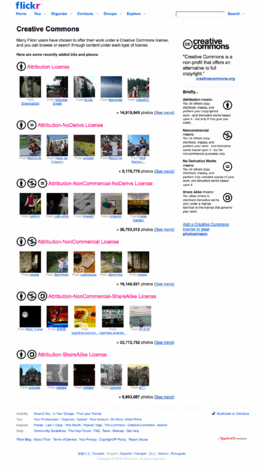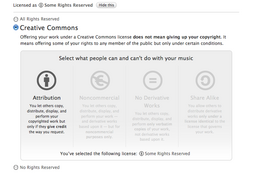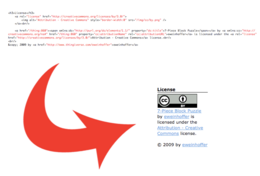Difference between revisions of "Web Integration/HowTo"
(→Assistance) |
|||
| (2 intermediate revisions by 2 users not shown) | |||
| Line 27: | Line 27: | ||
This can be combined with License Choice on File Upload to allow users to have the default license be, for example, CC:BY and in special cases some others be CC:BY-SA, or even All Rights Reserved. | This can be combined with License Choice on File Upload to allow users to have the default license be, for example, CC:BY and in special cases some others be CC:BY-SA, or even All Rights Reserved. | ||
| − | : Tools to use: | + | : '''Tools to use''': |
:: [[LicenseChooser.js]] or [[Web Services]] | :: [[LicenseChooser.js]] or [[Web Services]] | ||
| Line 40: | Line 40: | ||
This allows works to be scraped by search engines and other automatic content discovery services with associated license metadata. | This allows works to be scraped by search engines and other automatic content discovery services with associated license metadata. | ||
| − | : Tools to use: | + | : '''Tools to use''': |
:: [[RDFa]] and [[CcREL|ccREL]] | :: [[RDFa]] and [[CcREL|ccREL]] | ||
| − | : '''Best Practices Example''': [[ | + | : '''Best Practices Example''': [[Thingiverse]] |
: [[File:RDFa-Explanation.png|thumb|260px|border|<br>Read more about how CC uses [[RDFa]] and [[ccREL]] to signal to machines that a work is CC licensed.]] | : [[File:RDFa-Explanation.png|thumb|260px|border|<br>Read more about how CC uses [[RDFa]] and [[ccREL]] to signal to machines that a work is CC licensed.]] | ||
| Line 54: | Line 54: | ||
This is similar to practice to video embed code from services such as YouTUBE. However, this HTML is for bloggers and other republishers easily attribute a work fully and correctly. | This is similar to practice to video embed code from services such as YouTUBE. However, this HTML is for bloggers and other republishers easily attribute a work fully and correctly. | ||
| − | : Tools to use: | + | : '''Tools to use''': |
:: [[Web Services]], [[RDFa]], and [[CcREL|ccREL]] | :: [[Web Services]], [[RDFa]], and [[CcREL|ccREL]] | ||
| Line 81: | Line 81: | ||
== Assistance == | == Assistance == | ||
| − | If you are hoping to adopt this, please contact | + | If you are hoping to adopt this, please use the community support venues and direct contact information at http://creativecommons.org/contact |
<br clear="all"/> | <br clear="all"/> | ||
Latest revision as of 16:39, 17 March 2011
The goal of this HowTo is to provide a basic step-by-step guide to the technical concerns when incorporating CC license metadata functionality into your web application. This guide has been generalized from various plans for video, audio, or image sharing sites.
Below are 5 areas where integration can occur in your web application. While each web application may not need each of the 5 integrations, Creative Commons recommends that as many as practical are implemented.
Contents
License Choice on file upload
Users should be able to choose which license they want for each file they upload.
This will allow users to make fine-grain decisions about their works (so that some are CC and some are still All Rights Reserved)
- Tools to use:
- Best Practices Example: SoundCloud
Default License choice in account settings
In account settings, users should be able to specify a default license for their content they create on the site.
This can be combined with License Choice on File Upload to allow users to have the default license be, for example, CC:BY and in special cases some others be CC:BY-SA, or even All Rights Reserved.
- Tools to use:
- Best Practices Example: Flickr
-

Flickr's account settings provide a default license for users to apply to all of their uploaded works.
Include license RDFa on content pages
Including RDFa code signals to machines (search engines, browsers, etc) exactly how a specific work is licensed.
This allows works to be scraped by search engines and other automatic content discovery services with associated license metadata.
- Tools to use:
- Best Practices Example: Thingiverse
Include copyable attribution language with RDFa
This is similar to practice to video embed code from services such as YouTUBE. However, this HTML is for bloggers and other republishers easily attribute a work fully and correctly.
- Tools to use:
-
- Web Services, RDFa, and ccREL
- Best Practices Example: CC license deeds
License aware user interfaces
Utilize all of the license metadata to provide new and interesting interfaces to view content based on the license data.
- Tools to use:
- Best Practices Example: Flickr
-
 Flickr's CC portal represents a good way to break down CC content for end users.
Flickr's CC portal represents a good way to break down CC content for end users.
Adopters
We have a long list of Content Directories which are basically sites, projects and people who have implemented CC licensing and/or have some type of CC licensing. This is the best list of high level CC license adopters, all generated from the community. NOTE: CC does not have a database of content or keep a defacto list of all those who use CC licenses. The list above is used to provide examples.
Assistance
If you are hoping to adopt this, please use the community support venues and direct contact information at http://creativecommons.org/contact


